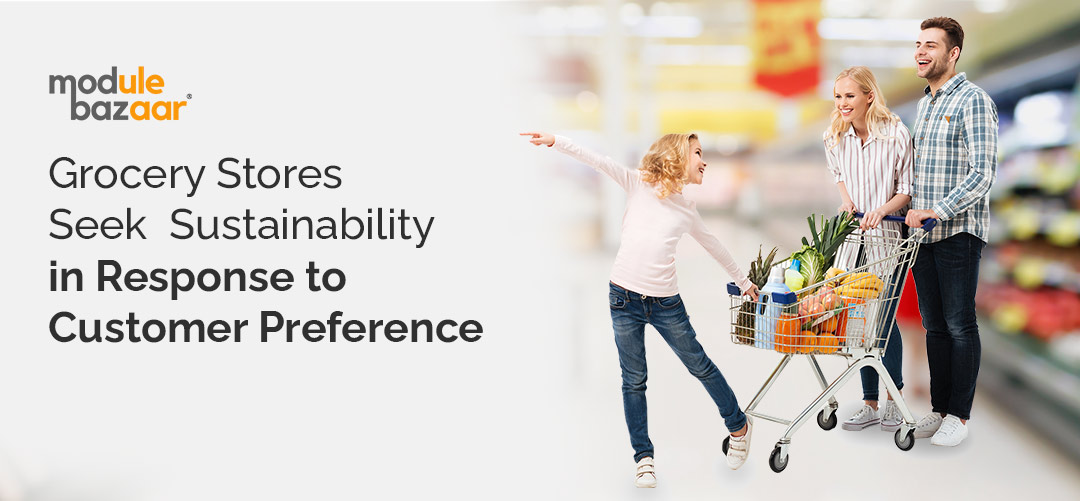Share the post "Grocery Stores Seek Sustainability in Response to Customer Preference"
Grocery stores have done better than many businesses during the pandemic, and they are seeking to expand through new trends in grocery sales. The amount of environmental harm done by the industry is an increasing concern, especially due to wasteful packaging and the rise of grocery delivery. The grocery retail sector is also estimated to use 2% of the world’s electricity. Studies have shown that customers are likely to prefer brands that promote sustainability, and in response, many grocery brands have introduced programs that will reduce waste, save money, and present a responsible brand image.
Grocery companies launch new initiatives
Several major retailers have taken major steps toward sustainability. Aldi announced a series of commitments to addressing these issues in its businesses. They plan to reduce greenhouse gas emissions by 26% by 2025 by using solar panels in their stores and distribution centers and purchasing green energy. Using natural refrigerants will reduce the impact of its store refrigerators. Aldi intends to cut 90% of its operational waste by 2025 and strive to reduce food waste by 50% by 2030.
They say the company has “recycling efforts in place for food, plastic film, corrugated cardboard, paper, metals and other materials,” so waste is limited. Beyond this, they can reduce the number of packaging materials consumed by 15% and convert all ALDI-exclusive packaging to reusable, recyclable, or compostable materials by 2025. Due to Aldi selling primarily store brands, they have the ability to adapt their packaging usage to a high degree. They are removing styrofoam and making it plastically reusable, recyclable, or compostable by 2025 while increasing the use of recyclable cardboard. Other companies are following the same trends to reduce waste, promote clean energy, and avoid pollution.
While it can be challenging for stores to change their procedures to be more sustainable, there are clear advantages for companies who take these steps. Surveys have shown that customers strongly favor companies that act with sustainability in mind. Food Dive reported last year that 78% of customers take the environment into consideration when making purchases. Brands that have a reputation for being environmentally conscious can build stronger brand loyalty and outcompete rivals while being even in other factors like pricing. Nielsen research found that sustainable consumers are 67% more engaged digitally, making them a valuable target market for the rising trend of digital food orders.
Read also: How to Build Grocery Shopping Apps for your Grocery Business
Handling Waste from Delivery
Whether through direct delivery apps or delivery services like Amazon Fresh and Instacart, grocery delivery is making a huge impact by offering convenience and time-saving. According to Oracle Retail, 92% of consumers surveyed who started shopping for groceries online will continue online moving forward, and 7 in 10 anticipate that they will shop online as much as or more frequently than they have during the pandemic. Overwhelmingly, consumers who bought groceries online had them delivered, with nearly 3 in 4 consumers opting for home delivery compared to 16% who picked up groceries in-store and 11% who used curbside pickup.
The rise of online delivery has created a new area of waste due to additional packaging and other requirements. Packages need to remain stable in transit and orders need to be bundled together, requiring more disposable packaging. But companies are beginning to introduce sustainability to this aspect of grocery shopping while it’s still new. Using recyclable or biodegradable paper and cardboard packaging rather than plastic can be less impactful on the environment. If phasing out plastic entirely is difficult, they can offer an option of paper or plastic packaging during the online order. Delivery can also be promoted as a more efficient alternative to making people travel to the store themselves, especially if companies implement fuel-saving routes and energy-efficient vehicles.
Phasing Out Single-Use Bags
Many grocery retailers have tried to phase out single-use plastic bags, and many governments have restricted their use as well. About a trillion single-use plastic bags are used in a year. However, during the pandemic, some of these measures were temporarily lifted to make it easier for customers to get groceries. In the fall of last year, 60% of customers at Giant Eagle told the company they did not feel safe using reusable bags, and demand for flexible plastic rose by 5%.
Now, retailers are issuing further support for ending single-use plastic bags. The “Beyond the Bag” initiative began last summer and many companies have joined in, including Walmart, Target, and CVS. Walmart announced that it was going bagless in many locations, encouraging customers to bring their own reusable bags, and reported that 78% of their customers in Vermont supported the program.
How Should Grocery Stores Plan Sustainability?
Stores should make sure they have an environmental sustainability plan that matches the long-term goals of reducing plastic waste, minimizing unnecessary packaging, and cutting other negative environmental impacts from logistics, storage, and transportation. Begin by researching alternatives to sources of waste and pollution. Many new biodegradable, recyclable, or multi-use solutions are being introduced in response to recent demand, so it’s a good idea to research whether a new option is available for packaging. If it’s not currently viable to implement drastic changes such as zero single-use plastics, a commitment to reduce usage gradually over a series of years can still make a positive impression on customers.
Sustainability will become a bigger and more important priority for grocery stores as customers become conscious of waste in their lives. Being part of their efforts to promote sustainability will build brand awareness and loyalty going forward, strengthening your customer base in the future.


